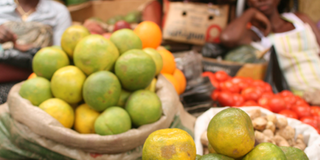April inflation eases to 6.7 % with increased food supply

High prices. Uganda’s inflation closed slightly higher than the previous year’s because of high prices of primary items.
What you need to know:
Actual fall in prices only observed when inflation figures decline to negative digits.
Kampala- Uganda’s annual headline inflation eased slightly by 0.4 percentage points in April on the back of a slowdown in food inflation due to increased food production and supply to markets.
The Consumer Price Index (CPI), the official measure of inflation released by the Uganda Bureau of Statistics (Ubos) yesterday, indicates the annual headline inflation rate for April declined to 6.7 per cent, from 7.1 per cent recorded in March.
Data from the bureau shows food crop inflation decreased to 25.4 per cent from 28.3 per cent while food inflation eased to 12.2 per cent from 12.7 per cent during the period.
The director macroeconomic statistics Ubos, Mr Chris Ndatira Mukiza, attributed the slowdown in inflation to increased food supplies to markets and decreases in prices of some manufactured products including sugar, cement and iron sheets.
Increased production
The price of a kilogramme of sugar for instance costs about Shs2,500 compared to Shs3,500 a year ago while a bag of cement costs Shs25,500, down from Shs28,000.
This is attributed to increased production and high competition in the market.
It should, however, be noted that while a rise in inflation erodes people’s purchasing power, a reduction (in positive digits), doesn’t necessarily mean that people will pay less for goods and services, rather it’s just a slowdown in the pace at which prices are increasing.
Headline inflation has been swinging between 8.1 and 6.7 per cent since October last year and April this year.
The volatility is hinged on the fact that Uganda’s inflation is mainly driven by food prices, which are always dependent on seasonal factors since Uganda depends on rain-fed agriculture.
Although Bank of Uganda recently forecast annual headline inflation to be in the range of 4-5 per cent in the next few months and 5.5 - 6.5 per cent over the next 12 months, it warned of possible stronger inflationary pressure risks arising from possible exchange rate depreciation, stronger fiscal demand from the fiscal sector and increase in food prices on account of drought and regional food supply shortfalls, which could drive up inflation.




